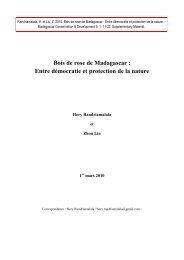Journal Madagascar Conservation - Madagascar Wildlife ...
Journal Madagascar Conservation - Madagascar Wildlife ...
Journal Madagascar Conservation - Madagascar Wildlife ...
You also want an ePaper? Increase the reach of your titles
YUMPU automatically turns print PDFs into web optimized ePapers that Google loves.
MADAGASCAR CONSERVATION & DEVELOPMENT VOLUME 3 | ISSUE 1 — DECEMBER 2008 PAGE 66<br />
FIGURE 1. ALT’s affiliated (AR) and future (FR) radio stations in the ‘Projet<br />
Radio’ in the regions of Toliara and Fianarantsoa in south <strong>Madagascar</strong>.<br />
elected to take care of the radio. The radios are both environ-<br />
mentally and economically appropriate, requiring no batteries or<br />
other external energy source. PR now involves more than 3,371<br />
Listening Groups, who agree to collaborate in the project by<br />
participating in programme research, production and monitor-<br />
ing to allow for an ‘adaptive research approach’ (see Figure 2).<br />
Research has shown that members of the community who are<br />
not directly involved with a Listening Group still benefit from the<br />
radio broadcasts due to information - sharing traditions within<br />
the village (Smith 2001, Metcalf 2006).<br />
In order to assure a holistic approach and high quality<br />
expertise, ALT has engaged in project cooperation with more<br />
than 47 local NGOs and service providers associated as Partners<br />
for Communication and Information Development (PCID)<br />
(for more details on PCID see Harford 2007). All affiliated radio<br />
stations are local community or commercial FM stations. Radio<br />
programmes are tailored in local dialects, using formats that are<br />
relevant to villagers. The participative production cycle process<br />
gets as close as possible to the needs of the audience, but<br />
without villagers actually making the programmes themselves.<br />
However, this year, following recommendations of the DFID<br />
(Department for International Development) evaluation (Metcalf<br />
et al. 2007), the project has begun training villagers to record<br />
programme content themselves.<br />
OBJECTIVES AND PLAN The objectives of this article are<br />
two fold: (i) to demonstrate the potential of radio broadcasting<br />
as a high efficiency/low cost means to meet IDGs / MDGs in<br />
<strong>Madagascar</strong>, but also beyond Malagasy border, by presenting<br />
ALT’s efforts in southern <strong>Madagascar</strong> published so far in the<br />
form of several project and evaluation reports on the ALT website<br />
(http://www.andrewleestrust.org/radio.htm), most specifically<br />
the DFID evaluation study which highlights project results in the<br />
TABLE 2. Broadcasted programmes in Ejeda between August 2004 and<br />
December 2005. In total, 463 radio broadcasting programmes were produced<br />
and aired by ALT and its PCID - partners, with all of these programmes being<br />
broadcasted at least once during the month they are received by the radio<br />
stations (numbers from Metcalf 2006).<br />
Topics # of Broadcasted Programs<br />
HIV/AIDS 55<br />
Breastfeeding 10<br />
Family Planning 10<br />
General Health 10<br />
Vaccinations (not Polio) 8<br />
Sexually Transmitted Diseases 7<br />
Hygiene 6<br />
Polio 5<br />
Malaria 5<br />
Prenatal Consultation 4<br />
Drinking Water 3<br />
Tuberculosis 2<br />
Cholera 1<br />
Planting Vegetables for Healthy Diet 1<br />
Pregnant Women’s Health 1<br />
context of the Millennium Development Goals; and (ii) to draw<br />
conclusions to which extent this approach can be used and<br />
extrapolated into other contexts, in answering the questions:<br />
How can radio broadcasting help to achieve the Millennium<br />
Development Goals? And how and where more emphasis could<br />
be given to the educational radio programmes? The key items<br />
here seem to be based on a secure network of cooperation at<br />
local, regional and national levels, on sufficient radio infrastructure,<br />
the functioning of adaptive reporting in radio broadcasting,<br />
and on the cost effectiveness of the PR’s goals, especially in<br />
terms of education, environment and public health.<br />
The preceding subsection outlined the concept, resources<br />
and methods of the approach adopted by ALT. In the following<br />
section are presented a selection of important results and<br />
impacts of the Radio Broadcasting Project pertaining to the<br />
MDGs, and the last section summarizes this article and gives<br />
some recommendations for potential further application of<br />
the PR’s ideas.<br />
RESULTS AND IMPACTS OF THE RADIO BROAD -<br />
CASTING PROJECT<br />
According to the chronology ‘IDG1996/ALT-PR1999/MDG2000/<br />
UN-Road-Map2007’, ALT set up this project before the Millennium<br />
Development Goals were laid down – ALT has never claimed<br />
that it purposefully set out to meet MDGs – but ALT did set<br />
out to empower people to alleviate the effects of poverty and<br />
extended its activity across all development sectors – hence ALT<br />
then hit the MDGs. Although the project has carried out various<br />
monitoring activities over the nine years of its operation, in 2006<br />
ALT secured funding from DFID (Department for International<br />
Development) to carry out an extensive evaluation of the project<br />
impacts. This was aimed to contribute to wider studies within<br />
the ICD (Information and Communication for Development)<br />
department of DFID to assess the importance of media for<br />
development. The consultancy group Media Support Solutions<br />
was commissioned by ALT to design and direct the evaluation



